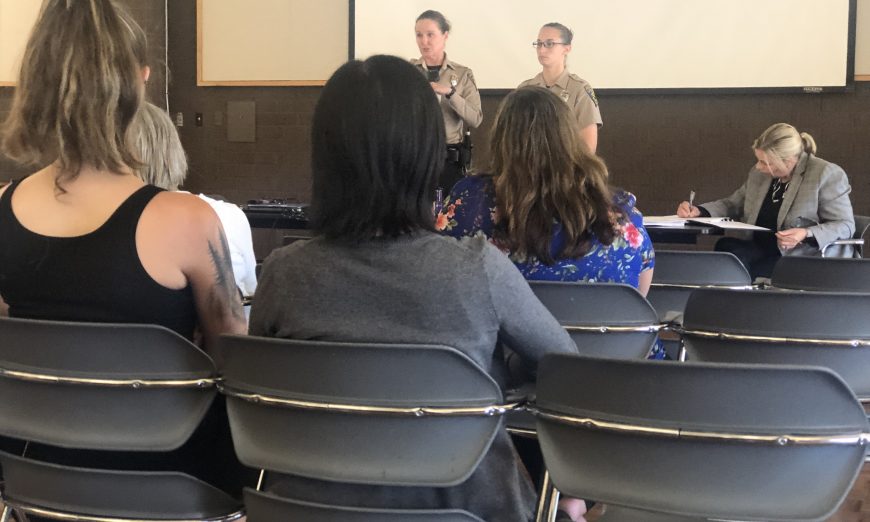After years of internal discussions and line by line overhaul of Sunnyvale’s Title 6 Municipal Code, the City is finally ready to move forward with a massive rewriting of the code.
“We haven’t had a major update or a comprehensive update to our Title 6 in about 30 years, since the 1970s,” said Sunnyvale Department of Public Safety (DPS) Animal Control Officer Michelle Morgan. “Obviously the landscape has changed here and continues to, so we’re updating our codes to reflect the changes in our community and to get in line with changes at state and other local jurisdictions.”
Sunnyvale has a long list of changes that it wants to make to the City’s code. Highlights include:
- Increasing the number of dogs and cats a household can have from three to four;
- Providing clearer guidelines about keeping animals in vehicles;
- Requiring people to report all bites by an animal that could carry rabies, right now you are only required to report dog bites;
- Allowing a licensing fee exemption for senior citizens;
- Requiring veterinarians within City limits to report rabies vaccinations in dogs;
In some cases, the changes are about providing clarity for residents, such as making it clearer what’s considered a nuisance by an animal. Another change will provide rules on what’s required for animals that live outdoors.
“People want to know exactly — when we say you need to provide proper shelter or proper water — they want to know exactly what that means,” said Morgan. “If they want to comply with what we’re asking them to do, it helps if you spell that out for people.”
Other changes were made because of the times we live in. The City has updated the time required to report found animals from six hours to two hours. Now, reporting doesn’t just have to happen by calling animal control, it can also happen on Twitter, Facebook or Nextdoor.
“It’s scary [to lose an animal],” said Morgan. “Six hours can feel like a lifetime, especially now with social media.”
Morgan says the department went line by line through the Title 6 Municipal Code over a number of years before the changes were determined.
“We did a lot of research looking at what other local jurisdictions were doing, updated state laws,” said Morgan. “[We] looked at areas where we felt like we could just update; other areas where we felt like we needed to remove something completely. Some areas where we needed to replace it with a new ordinance.”
More than a dozen people showed up for the first community meeting to review the changes and there were some mixed reviews.
“I like the fact that people can now have four animals,” said resident Marian Sadowski.
But Rhys Jacobson who lives in the San Miguel Neighborhood wasn’t happy. Jacobson runs a trap and release program for feral cats. When she traps a cat, she gets them spayed or neutered and then releases them back into the wild. She says the new codes don’t cover the kind of program she runs.
“You end up with some weird situations in there where your cat is not really a housecat, but isn’t really feral anymore either,” said Jacobson. “What are you supposed to do? That’s a gray area in the law. I really wish it were addressed better in our laws. I wish that there were actual exceptions for the feral cats.”
Sunnyvale held a Facebook Live event on Aug. 8 to address the changes to the code. Video from that event is now on Sunnyvale DPS’s Facebook page.
The City Council will address the changes to Title 6 during its meeting on Sept. 24.
Update: On Oct. 8, the Sunnyvale City Council approved the proposed changes with one modification to prohibit unsprayed or un-neutered dogs over 18 months old from dog parks. The ordinance will take effect on Nov. 7.







How do I get in contact with Rhys? I’d like to help and interested in the catch and release program for my apartment community in Cupertino. People leave these poor cats behind in our very large complex it’s really sad.
I’m a writer, activist and proud cat owner of two litter mates that are strictly indoor.
“TNR Works”. I hear that a lot. What does that mean? For most of use that means the cats will be gone in a few years but for TNR people that means the dense hoard of cats continue indefinitely as more cats join while other cats die, they never go away. TNR advocats do not take into consideration the habitats they wipe out with all the food and the cats killing off beneficial native animals. I’ve lived near TNR cat hoards 2X and we were overrun by rats mice cockroaches rabies reservoir racoons and skunks. There were swarms of flies, fleas , ticks. Tons of biohazard feral cats feces and the constant horrible smell. The don’t are impossible to retrap and since they feed close together from common bowls they are rich with diseases and parasites. All TNR people care about is their hobby of feeding feral cats.
If Ms. Jacobson’s cats are not friendly enough to keep inside as house pets, they could be yard cats. She needs a cat-proof fence around her yard (can be purchased, or directions for building are on the Internet) clean dishes for food and water, a sandpile for defecation and urination (scooped daily), places to hide, things to climb on (kept well away from the fence), and plenty of toys They will be safer in her yard than back on the street. If she loves the cats she neuters, she will want to keep them safe.